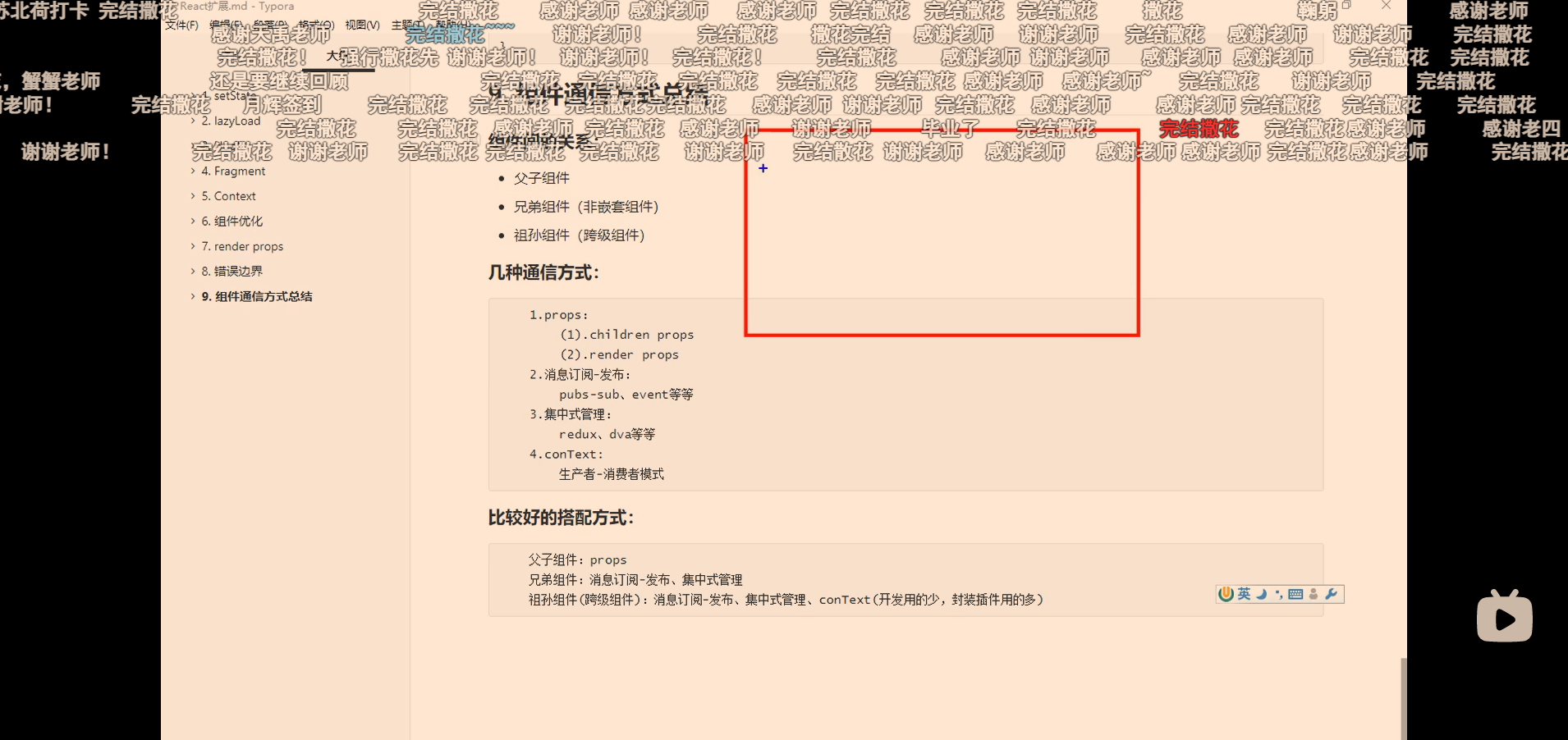一、setState
setState更新状态的2种写法
- setState(stateChange, [callback])——对象式的setState
- stateChange为状态改变对象(该对象可以体现出状态的更改)
- callback是可选的回调函数, 它在状态更新完毕、界面也更新后(render调用后)才被调用
- setState(updater, [callback])——函数式的setState
- updater为返回stateChange对象的函数。
- updater可以接收到state和props。
- callback是可选的回调函数, 它在状态更新、界面也更新后(render调用后)才被调用。
总结:
- 对象式的setState是函数式的setState的简写方式(语法糖)
- 使用原则:
- 如果新状态不依赖于原状态 ===> 使用对象方式
- 如果新状态依赖于原状态 ===> 使用函数方式
- 如果需要在setState()执行后获取最新的状态数据, 要在第二个callback函数中读取
- 写法都差不多,看个人习惯。
1
2
3
4
5
6
7
8
9
10
11
12
13
14
15
16
17
18
19
20
21
22
23
24
25
26
27
28
29
30
| import React, { Component } from 'react';
export default class Demo extends Component {
state = { count: 0 };
add = () => {
//setState的对象式写法
//this.setState是异步的,可以通过callback获取更新后的信息
// const { count } = this.state;
// this.setState({ count: count + 1 },() => {
// console.log(this.state.count);
// });
//setState的函数式写法
//默认传递state props两个参数
this.setState((state, props) => {
return { count: state.count + 1 };
});
//简写方式
this.setState((state) => ({ count: this.state.count + 1 }));
};
render() {
return (
<div>
<h2>求和为{this.state.count}</h2>
<button onClick={this.add}>点我+1</button>
</div>
);
}
}
|
二、lazyLoad
路由组件懒加载 — lazyLoad
通过React的lazy函数配合import()函数动态加载路由组件 ===> 路由组件代码会被分开打包*
1
2
3
4
5
6
7
8
9
| const Login = lazy(()=>import('@/pages/Login'))
//2.通过<Suspense>指定在加载得到路由打包文件前显示一个自定义loading界面
<Suspense fallback={<h1>loading.....</h1>}>
<Switch>
<Route path="/xxx" component={Xxxx}/>
<Redirect to="/login"/>
</Switch>
</Suspense>
|
1
2
3
4
5
6
7
8
9
10
11
12
13
14
15
16
17
18
19
20
21
22
23
24
25
26
27
28
29
30
31
32
33
34
35
36
37
38
39
40
41
42
43
44
45
46
47
48
49
| import React, { Component, lazy, Suspense } from 'react';
import { Route, Switch, Redirect, Link } from 'react-router-dom';
//懒加载方式加载路由
const Home = lazy(() => import('../Home'));
const About = lazy(() => import('../About'));
export default class Lazy extends Component {
render() {
return (
<div>
<div className="row">
<div className="col-xs-offset-2 col-xs-8">
<div className="page-header">
<h2>React Router Demo</h2>
</div>
</div>
</div>
<div className="row">
<div className="col-xs-2 col-xs-offset-2">
<div className="list-group">
<Link to="/about" children="About">
About
</Link>
<Link to="/home" children="Home">
Home
</Link>
</div>
</div>
<div className="col-xs-6">
<div className="panel">
<div className="panel-body">
{/* 注册路由 */}
{/* Suspense中的fallback用于指定懒加载路由组件时的显示 */}
<Suspense fallback={<h1>Loading</h1>}>
<Switch>
<Route path="/about" component={About} />
<Route path="/home/" component={Home} />
<Redirect to="/home" />
</Switch>
</Suspense>
</div>
</div>
</div>
</div>
</div>
);
}
}
|
三、React Hooks
Hook是React 16.8.0版本增加的新特性/新语法
可以让你在函数组件中使用 state 以及其他的 React 特性
useState
1
2
3
4
5
6
7
8
9
10
11
12
13
14
15
16
17
18
19
20
21
22
23
24
25
26
27
28
29
30
31
32
33
34
35
36
| import React from 'react';
// export default class Demo extends React.Component {
// add = () => {
// this.setState((state, props) => {
// return { count: state.count + 1 };
// });
// };
// render() {
// return (
// <div>
// <h2>求和为{this.state.count}</h2>
// <button onClick={this.add}>点我+1</button>
// </div>
// );
// }
// }
function Demo() {
//使用useState
const [count, setCount] = React.useState(0);
const [name, setName] = React.useState('tom');
function add() {
setCount((count) => count + 1);
}
function change() {
setName((name) => 'jack');
}
return (
<div>
<h2>求和为{count}</h2>
<h2>名字为{name}</h2>
<button onClick={add}>点我+1</button>
<button onClick={change}>点我改名</button>
</div>
);
}
export default Demo;
|
useEffect
Effect Hook 可以让你在函数组件中执行副作用操作(用于模拟类组件中的生命周期钩子)
- React中的副作用操作:
- 发ajax请求数据获取
- 设置订阅 / 启动定时器
- 手动更改真实DOM
语法和说明:
1
2
3
4
5
6
7
8
9
10
11
12
13
| useEffect(() => {
// 在此可以执行任何带副作用操作
return () => { // 在组件卸载前执行
// 在此做一些收尾工作, 比如清除定时器/取消订阅等
}
}, [stateValue]) // 如果指定的是[], 回调函数只会在第一次render()后执行
|
可以把 useEffect Hook 看做如下三个函数的组合
- componentDidMount()
- componentDidUpdate()
- componentWillUnmount()
1
2
3
4
5
6
7
8
9
10
11
12
13
14
15
16
17
18
| /*useEffect传递两个参数
1、第一个参数为回调函数
2、第二个参数为一个数组,起到监听作用
3、不传递第二个参数,componentDidMount 和 componentDidUpdate都会被检测并响应
4、第二个参数传递的为一个空数组,代表生命周期函数都不会被检测
5、如果传递的不是空数组,在传的数组中的值发生变化时会监听componentDidUpdate
6、返回一个函数代表componentWillUnmount生命周期钩子
*/
React.useEffect(() => {
console.log(1);
setInterval(() => {
setCount((count) => count + 1);
},1000);
//componentWillUnomunt
return () => {
console.log(1);
}
},[count]);
|
useRef
Ref Hook可以在函数组件中存储/查找组件内的标签或任意其它数据
语法: const refContainer = useRef()
作用:保存标签对象,功能与React.createRef()一样
1
2
3
4
5
6
| const myRef = React.useRef();
function show() {
console.log(myRef.current.value);
}
<input type="text" ref={myRef} />
<button onClick={show}></button>
|
四、Fragment
正常写组件引用组件结构:
1
2
3
4
5
| return (
<div>
<Demo />
</div>
);
|
每次都要嵌套一个无用的div标签
可以使用Fragment来替换div,页面在渲染的时候不会渲染Fragment,省掉了无用的嵌套
1
2
3
4
5
6
7
8
9
10
11
| import React, { Component, Fragment } from 'react';
export default class App extends Component {
render() {
return (
<Fragment>
<Demo />
</Fragment>
);
}
}
|
使用空标签也可以:
1
2
3
4
5
6
7
8
9
10
| import React, { Component, Fragment } from 'react';
export default class App extends Component {
render() {
return (
<>
<Demo />
</>
);
}
}
|
两者不同:
Fragmengt可以传递key值来表示唯一,且只能传递key
空标签不可以
1
2
3
4
5
6
7
8
9
10
| import React, { Component, Fragment } from 'react';
export default class App extends Component {
render() {
return (
<Fragment key={1}>
<Demo />
</Fragment>
);
}
}
|
五、context
context适用于祖组件与后代组件间的组件通信
1
| const MyContext = React.createContext()
|
- 渲染子组时,外面包裹xxxContext.Provider, 通过value属性给后代组件传递数据:
1
2
3
| <MyContext.Provider value={数据}>
子组件
</MyContext.Provider>
|
1
2
3
4
5
6
7
8
9
10
11
12
| //第一种方式:仅适用于类组件
static contextType = xxxContext // 声明接收context
this.context // 读取context中的value数据
//第二种方式: 函数组件与类组件都可以
<xxxContext.Consumer>
{
value => ( // value就是context中的value数据
要显示的内容
)
}
</xxxContext.Consumer>
|
1
2
3
4
5
6
7
8
9
10
11
12
13
14
15
16
17
18
19
20
21
22
23
24
25
26
27
28
29
30
31
32
33
34
35
36
37
38
39
40
41
42
43
44
45
46
47
48
49
50
51
52
53
54
55
56
57
| import React, { Component } from 'react';
const MyContext = React.createContext();
export default class A extends Component {
state = { username: 'jack', age: 20 };
render() {
const { username, age } = this.state;
return (
<div>
<h1>我是A组件</h1>
<h1>我的名字是{this.state.username}</h1>
<MyContext.Provider value={{ username, age }}>
<B />
</MyContext.Provider>
</div>
);
}
}
class B extends Component {
render() {
return (
<div>
<h3>我是B组件</h3>
<h3>我从A组件接收名字是</h3>
<C />
</div>
);
}
}
// class C extends Component {
// //第一种方式:仅适用于类组件
// static contextType = MyContext; // 声明接收context
// render() {
// return (
// <div>
// <h5>我是C组件</h5>
// <h5>我从A组件接收到的名字是{this.context.username} --- 年龄是{this.context.age}</h5>
// </div>
// );
// }
// }
function C() {
return (
<div>
<h5>我是C组件</h5>
<MyContext.Consumer>
{(value) => {
// console.log(value);
return `从A组件接收到的名字是${value.username}`;
}}
</MyContext.Consumer>
</div>
);
}
|
注意:在应用开发中一般不用context, 一般都它的封装react插件
六、PureComponent
Component的2个问题
- 只要执行setState(),即使不改变状态数据, 组件也会重新render()
- 当前组件重新render(), 就会自动重新render子组件 ==> 效率低
1
2
3
4
5
6
7
8
9
10
11
12
13
14
15
16
17
18
19
20
21
22
23
24
25
| import React, { Component } from 'react';
export default class A extends Component {
state = { carname: 'BWM' };
change = () => {
this.setState({});
};
render() {
console.log('A组件渲染');
return (
<div>
<h2>车名:{this.state.carname}</h2>
<button onClick={this.change}>点我换车</button>
<B />
</div>
);
}
}
class B extends Component {
render() {
console.log('B组件渲染');
return <div></div>;
}
}
|

- 初始渲染两个组件时分别render一次
- 当点击按钮时,setState没有改变状态,B组件也没接收值,但还是分别进行了render
- 这就是两个问题
原因
Component中的shouldComponentUpdate()总是返回true
效率高的做法
只有当组件的state或props数据发生改变时才重新render()
解决
- 办法1:
- 重写shouldComponentUpdate()方法
- 比较新旧state或props数据, 如果有变化才返回true, 如果没有返回false
- 办法2:
- 使用PureComponent
- PureComponent重写了shouldComponentUpdate(), 只有state或props数据有变化才返回true
1
2
| import React, { PureComponent } from 'react';
export default class A extends PureComponent {}
|
- 注意:
- PureComponent只是进行state和props数据的浅比较, 如果只是数据对象内部数据变了, 返回false
- 不要直接修改state数据, 而是要产生新数据
- 项目中一般使用PureComponent来优化
七、render props
如何向组件内部动态传入带内容的结构(标签)?
children props:
1
2
3
4
5
6
7
8
9
10
11
12
13
14
15
16
17
18
19
20
21
22
23
| import React, { Component } from 'react';
export default class Parent extends Component {
render() {
return (
<div>
<h1>父组件Parent</h1>
<A> hello </A>
</div>
);
}
}
class A extends Component {
state = { name: 'jack' };
render() {
return (
<div>
<h3>子组件A</h3>
{/*children props方式来接受 */}
<h4>{this.props.children}</h4>
</div>
);
}
}
|
render props:
1
2
3
4
5
6
7
8
9
10
11
12
13
14
15
16
17
18
19
20
21
22
23
24
25
26
27
28
29
30
31
32
33
34
35
36
37
38
39
40
41
42
| import React, { Component } from 'react';
export default class Parent extends Component {
render() {
return (
<div>
<h1>父组件Parent</h1>
{/* <A> hello </A> */}
{/* 传递一个render属性,值是一个函数,函数返回的是一个组件B */}
<A render={(name) => <B name={name} />}></A>
</div>
);
}
}
class A extends Component {
state = { name: 'jack' };
render() {
return (
<div>
<h3>子组件A</h3>
{/* children props方式来接受 */}
{/* <h4>{this.props.children}</h4> */}
{/* 通过this.props.render()来接受,类似于this.props.children */}
{/* 但是可以传递数据 如this.state.name */}
<h4>{this.props.render(this.state.name)}</h4>
</div>
);
}
}
class B extends Component {
render() {
return (
<div>
<h5>孙组件B</h5>
{/* 接收的name在这里展示 */}
<h4>{this.props.name}</h4>
</div>
);
}
}
|
其实this.props.render()相当于一个插槽,想引入哪个插件,在render属性里修改就可以。
比如想展示C组件
1
| <A render={(name) => <C name={name} />}></A>
|
八、Error boundary - 错误边界
错误边界:用来捕获后代组件错误,渲染出备用页面
特点:
- 只能捕获后代组件生命周期产生的错误,
- 不能捕获自己组件产生的错误和其他组件在合成事件、定时器中产生的错误
1
2
3
4
5
6
7
8
9
10
11
12
13
14
15
16
17
18
19
20
21
22
23
| import React, { Component } from 'react';
import Child from './Child';
export default class Parent extends Component {
state = { hasError: '' };
//生命周期函数,一旦后代组件报错,就会触发
static getDerivedStateFromError(error) {
return {
// 在render之前触发
// 返回新的state
hasError: error,
};
}
compomentDidCatch() {
//一般用于统计页面发生的错误,发送请求给后台进行处理
}
render() {
return (
<div>
this.state.hasError ? <h2>网络加载缓慢,请等待...</h2> : <Child />
</div>
);
}
}
|
九、组件通信方式总结
props:
- children props
- render props
消息订阅-发布:
集中式管理:
conText:
建议使用的方式:
- 父子组件:props
- 兄弟组件(非嵌套组件):消息订阅-发布、集中式管理
- 祖孙组件(跨级组件):消息订阅-发布、集中式管理、conText(用的少)
完结
2021.11.02-2021.12.04
历时将近一个月,学完react基础。
下一步实战 - webpack - js底层 - vue3
感谢尚硅谷天禹男神老师,react课程当数第一。
链接https://www.bilibili.com/video/BV1wy4y1D7JT?from=search&seid=16816498486462185277&spm_id_from=333.337.0.0








